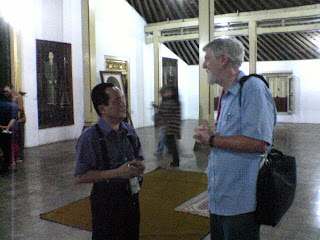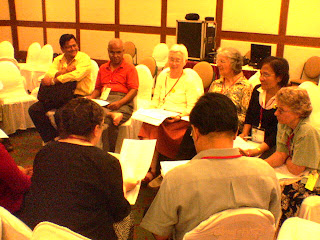
Natal tentu bukan peristiwa baru bagi kita. Berpuluh-puluh kali kita merayakannya. Dalam satu kali masa raya Natal, seorang rohaniwan bisa-bisa mengikuti Natal sampai dua puluh acara! Natal memang masa yang sibuk! Aneh, suatu paradoks! Kendati disebut sebagai holiday season, musim liburan, namun Natal adalah masa yang paling sibuk bagi rohaniwan, bagi majelis jemaat, bagi pengurus komisi dan bagi aktivis-aktivis Kristen.
Namun demikian, tak jarang kita malahan telah melupakan bahwa Natal merupakan kelahiran Yesus, yang kita sanjung dan sembah sebagai Tuhan dan Juruselamat. Kita lupa bahwa Natal menjadi peristiwa kelahiran yang paling revolusioner! Betapa tidak, kelahiran bayi yang mungil di dusun Betlehem telah membuat gonjang-ganjing kerajaan boneka pimpinan Herodes agung, kegelisahan di hati para imam, ketidaktahuan orang-orang Yahudi bahwa pada waktu itulah, lahir Raja Mesias yang mereka nanti-nantikan kedatangan-Nya selama ribuan tahun!
Ah, jangan-jangan kita pun laksana orang-orang yang dekat dengan berita Mesias, tetapi tak tahu menahu, acuh tak acuh dengan kedatangan-Nya. Bukankah berita Natal telah kita hapal dengan baik? Siapa saja yang terlibat di dalam kisah itu, di mana terjadinya, tragedi apa saja yang mengikuti kelahiran sang Bayi. Justru di situlah titik ketika kita tak lagi siap menyambut kedatangan Kristus.
Kesibukan di tiap Natal, terkadang telah merampas kedamaian dan makna terdalam dari kedatangan Sang Mesias yang memberikan kita hidup, dan memberikannya dengan berkelimpahan. Tak kurang sibuknya kita mempersiapkan perayaan dan pagelaran besar-besaran, sementara pintu hati kita masih tertutup bagi kedatangan-Nya, bagai para pemilik rumah di Betlehem yang berkata kepada Yusuf dan Maria, “Tak ada tempat lagi di sini!” Natal, telahlah hilang maknanya di hati kita, dan Kristus tidak dilahirkan di palungan hati kita.
Ironis, sungguh! Mereka yang siap justru orang-orang yang tidak diharapkan. Para gembala yang adalah warga kelas paria di dalam stratifikasi masyarakat Yahudi, para majus dari Timur yang oleh orang Yahudi dianggap najis, karena secara garis keturunan, mereka tidak ada kait-mengaitnya dengan Abraham, Bapa iman yang mereka banggakan; mereka tidak mengenal Taurat yang diturunkan Allah kepada Musa, hamba Allah.
Namun demikian, tak jarang kita malahan telah melupakan bahwa Natal merupakan kelahiran Yesus, yang kita sanjung dan sembah sebagai Tuhan dan Juruselamat. Kita lupa bahwa Natal menjadi peristiwa kelahiran yang paling revolusioner! Betapa tidak, kelahiran bayi yang mungil di dusun Betlehem telah membuat gonjang-ganjing kerajaan boneka pimpinan Herodes agung, kegelisahan di hati para imam, ketidaktahuan orang-orang Yahudi bahwa pada waktu itulah, lahir Raja Mesias yang mereka nanti-nantikan kedatangan-Nya selama ribuan tahun!
Ah, jangan-jangan kita pun laksana orang-orang yang dekat dengan berita Mesias, tetapi tak tahu menahu, acuh tak acuh dengan kedatangan-Nya. Bukankah berita Natal telah kita hapal dengan baik? Siapa saja yang terlibat di dalam kisah itu, di mana terjadinya, tragedi apa saja yang mengikuti kelahiran sang Bayi. Justru di situlah titik ketika kita tak lagi siap menyambut kedatangan Kristus.
Kesibukan di tiap Natal, terkadang telah merampas kedamaian dan makna terdalam dari kedatangan Sang Mesias yang memberikan kita hidup, dan memberikannya dengan berkelimpahan. Tak kurang sibuknya kita mempersiapkan perayaan dan pagelaran besar-besaran, sementara pintu hati kita masih tertutup bagi kedatangan-Nya, bagai para pemilik rumah di Betlehem yang berkata kepada Yusuf dan Maria, “Tak ada tempat lagi di sini!” Natal, telahlah hilang maknanya di hati kita, dan Kristus tidak dilahirkan di palungan hati kita.
Ironis, sungguh! Mereka yang siap justru orang-orang yang tidak diharapkan. Para gembala yang adalah warga kelas paria di dalam stratifikasi masyarakat Yahudi, para majus dari Timur yang oleh orang Yahudi dianggap najis, karena secara garis keturunan, mereka tidak ada kait-mengaitnya dengan Abraham, Bapa iman yang mereka banggakan; mereka tidak mengenal Taurat yang diturunkan Allah kepada Musa, hamba Allah.
Kepada orang-orang yang tidak terduga, dan tidak diharapkan ini, sukacita itu justru dinyatakan. Pagelaran kantata akbar paduan suara surga dipentaskan di padang Efrata! Bintang yang kemilaunya tiada tara dicermati oleh orang-orang majus. Dan, merekalah yang bergegas untuk pergi menjumpai Sang Raja di dalam palungan Betlehem.
Di tengah-tengah hiruk-pikuknya musim Natal yang pada kenyataannya merupakan high season bagi kita, marilah sejenak kita menarik diri dari keramaian. Izinkan diri kita untuk menjadi orang yang tidak penting! Berilah tempat untuk tenang, tanggalkan semua atribut rohani, dan pangkat jabatan kita di kantor atau tempat kerja. Kenakanlah kini jubah orang-orang yang terpinggirkan oleh kebisingan kota yang padat, mereka yang terbuang, mereka yang masih jauh! Sebab kepada merekalah kasih karunia Allah dinampakkan dengan dahsyatnya! Bagi merekalah Kristus datang. Selama kita masih mengenakan jubah Herodes dan atribut para imam serta ahli Taurat, niscaya tak pernah kita siap menerima kedatangan Kristus.
Sajak di bawah ini mengingatkan kita semua akan arti kedatangan Kristus, dan kepada siapa Kristus mau datang.
Kristus yang dirayakan pada setiap Natal, dengarlah doaku
bagi mereka yang tidak memiliki Natal.
Bagi jutaan orang yang tidur dengan kelaparan
pada malam ini, dan pada tiap-tiap malam.
Bagi anak-anak yang di rumahnya lilin-lilin telah
dimusnahkan pada hari-hari ini oleh perang, wabah dan ketakutan.
Bagi anak-anak laki-laki dan perempuan yang tangannya menempel di kaca etalase toko
tatkala mata mereka memandangi keindahan yang tidak pernah mereka dapat sentuh.
Bagi mereka yang hati-hatinya dirobek-robek oleh kebencian, diremukkan oleh curiga,
digerogoti oleh pikiran sempit dan kecongkakan.
Bagi mereka yang tidak memiliki Natal pada hari ini,
ya Kristus yang kasih-Nya tak pernah mati, kiranya hadirat-Mu datang dengan sukacita dan kesembuhan pada sayap-sayapnya.
—Percy R. Hayward, “For Those Who Have No Christmas” in Young People’s Prayers














































